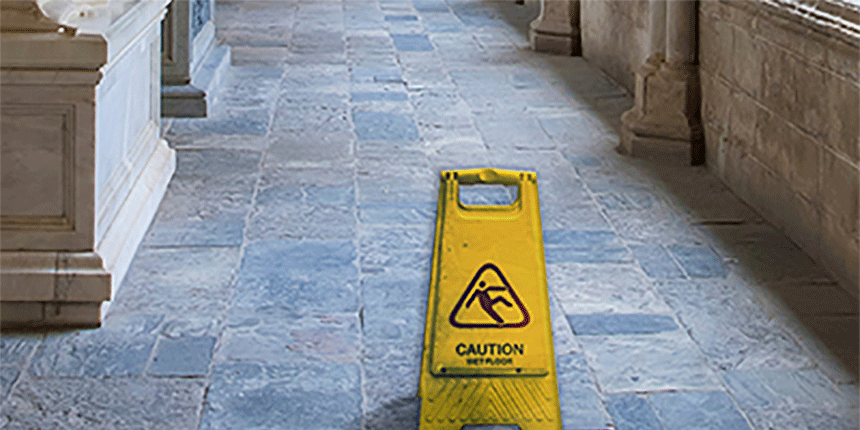Cleaning
06 August 2019
How efficient and effective cleaning methods can help to prevent slips and trips.

Slips and trips - hazards with cleaning
Many hazards can be eliminated with good housekeeping and proper cleaning. Poor housekeeping can increase the risk of people tripping by leaving clutter on the floor. Good housekeeping is dependent on the provision of adequate storage for equipment and materials being used properly.
Poorly planned cleaning can introduce other hazards by leaving floors wet or obstructed with waste materials and trailing cables. A good system relies on the use of proper cleaning techniques along with appropriate training for those involved.
Slips and trips in historic properties
The biggest challenge in an historic property is there is less likely to be a dedicated cleaning team. In many instances, cleaning activity will be undertaken by regular staff or volunteers and be additional to their core duties. Sometimes, specialist conservation cleaners might be employed but they are more likely to concentrate on conservation aspects rather than generally making properties clean and safe.
There could also be a wide variety of flooring types, some of which could be slippery particularly when wet, such as stone and polished wood and each might require a different way of cleaning them. Many historic properties have few power points to plug in electrical equipment, and limited storage space. This can lead to trailing cables and clutter which people could trip over.
Top tips for preventing slips and trips
Here are some solutions and considerations to overcome these challenges:
- Develop and communicate a clear cleaning ‘plan’ that sets out how surfaces are to be cleaned; any precautions that need to be taken; and checks that need to be made once the cleaning is complete.
- Arrange for cleaning to be undertaken only when the premises are closed and there are no staff or customers/visitors on site.
- Provide suitable spill stations in high risk areas (e.g. bar areas, toilets and workshops) so that unexpected spills can be dealt with quickly.
- Carry out regular inspections of toilet floors during busy periods, so spillages can be dealt with promptly. Record details of inspections and retain these records
- Invest in a cordless vacuum to avoid long trailing cables.
- Train staff to use the nearest socket for electrical equipment to avoid trailing cables.
- Provide simple reusable overshoes to cleaning staff to increase the slip resistance of their footwear.
- Remove warning signs once the floor is dry so that they remain effective.
- Encourage a ‘see it, sort it or report it’ policy amongst staff and volunteers.
- Be creative to provide adequate storage space and provide bins to clear items and waste away from walkways and access routes.
- Ensure detergent solutions and equipment are removed correctly and as soon as it is safe to do so - or they can become a risk.
- Use barriers to make an area being cleaned safe; extend the cordon to include cables, other equipment and bags of waste.
Always consider...
- If your precautions are adequate given your circumstances
- Completing a risk assessment if you need one to comply with health and safety law
- Providing information and training for any employees and volunteers on what they need to do
- Making periodic checks that your arrangements and precautions remain adequate
- Documenting your arrangements and responsibilities for preventing slips and trips, perhaps as part of your health and safety policy
- Highlighting challenging areas in your visitor and user information.